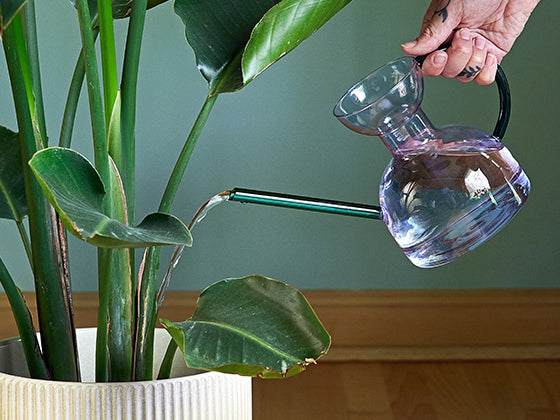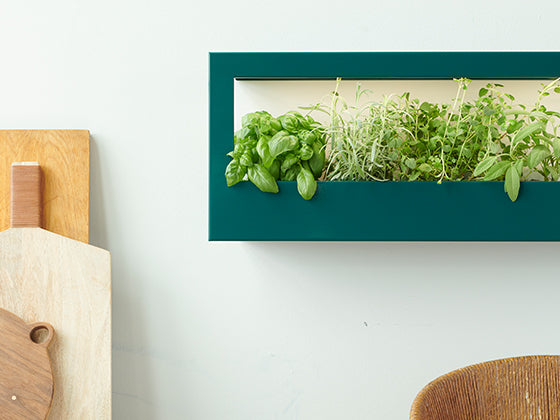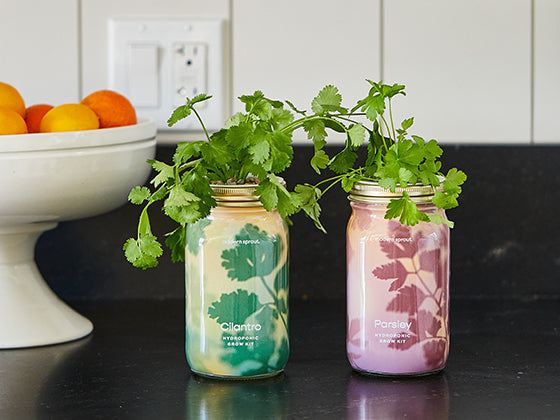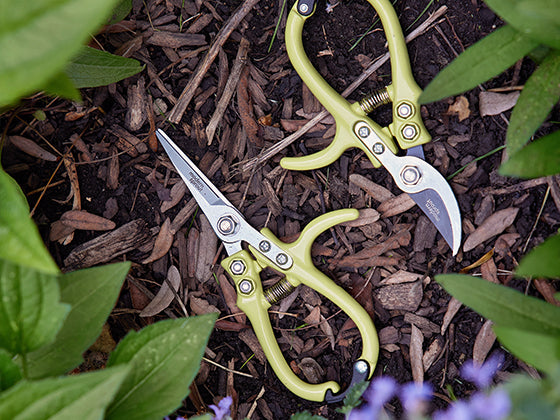FAQs
Life's hard. Plants shouldn't be.
Basics
Passive hydroponics is a method of growing plants without soil. A combination of an inert porous growing medium and a wick transports water and nutrients to the plant roots via capillary action. The nutrient solution (water and fertilizer) are held in a reservoir and taken up as needed, providing the perfect balance of water to oxygen.
Due to seed import restrictions we cannot ship our Garden Jars to most countries outside the U.S. and Canada.
Please note: Orders must have been purchased through our website in order to qualify for a return. To return your order, please reach out to service@modsprout.com to see if your order qualifies. Once we establish a return is warranted, we will send over a link to download a return label. Once we receive your return, it will take 1-2 weeks to process payment back to your credit card. You will receive an email confirmation to notify you that your payment has been refunded.
**Modern Sprout is not responsible for damaged products; if your item does not arrive in good condition we will not be able to issue you a return. It is recommended that you pack the item exactly the way you received it. Please note we do not assume the cost of shipping, but you can choose whatever is the most economical for you, whether that be USPS, FedEx or UPS. Any box is fine, as long as the product is protected and comes back in the condition that it was received!
LIMITED WARRANTY STATEMENT: Modern Sprout warrants that it will repair, replace or refund, at our sole discretion, any product that is defective in materials or workmanship for a period of one year from the date of original purchase, unless stated otherwise.
Indoor Garden Kits
Indoor Garden Kits are designed for indoor use, but can be put outside. Be mindful that the planter does not have a drain hole, and if the reservoir floods it may drown the roots. Bring your Garden Kit inside if temps dip below freezing.
The recycled glass grow medium and polypro wick can both be reused—simply rinse with hot water. Add a new coco pot, seeds and use soil or coco pith to help seeds germinate. Use a water soluble fertilizer and follow its instructions.
Over time, roots will grow through the net pot into the reservoir. Transplanting can be risky as doing so can disrupt a mature root system.
Fear not! Coco retains moisture needed for germination; however, harmless fungus can grow because of this moisture. Sprinkle more carbon or cinnamon on coco to get rid of fungus as it can stunt plant growth.
Growing plants hydroponically or in soilless grow medium requires water soluble nutrients in order to be grown successfully. Water soluble nutrients are taken into the plant through their root systems. Over time, these nutrients can accumulate in the grow medium and form white specs. You can get rid of this buildup by scraping it off and changing the water.
Hydro Planters
Hydroponics is a system for growing with a solution of water and nutrients in a soilless medium. In a top-fed active hydroponic system, a pump moves the water and nutrient solution from a reservoir up to plant roots, where the roots take what they need and the rest recycles back into the reservoir. Hydroponics offers a method of cultivation that’s clean, sustainable and yields fantastic results. Plants thrive because they get fed when they need it, where they need it. When compared to soil gardening, hydroponics uses an estimated 80% less water, grows plants 30% faster, and occupies ¼ of the space. When a planter is labeled “self-watering” it most likely utilizes passive hydroponics (like our Garden Jars). Passive hydroponic planters feature a wicking system with soil or soilless grow medium. Passive hydroponic planters don’t grow plants as quickly as active, and have a slightly more limited selections of plants that will thrive.
Substantial light and proper temperatures are crucial for fast growth, healthy plants, and high yields. Your planter should be placed in a well lit location—unobstructed south or west-facing windows will produce the best results. Most leafy greens want at least 4-6hrs of direct light, while flowering and fruiting plants want 10-12hrs. Even with limited light you have plant options, including chives, lemon balm, mint, sage, shiso, lettuce, arugula, kale, Swiss chard, spinach, peas and a variety of houseplants. The optimal temperature for most plants is 65⁰-75⁰F. Supplemental light—especially during winter months—enables year-round indoor growing and fills the gaps during dark days. Herbs and leafy greens will benefit from a fluorescent light bulbs (tubes or CFLs). LED grow lights are becoming more popular and efficient, and are available in two color spectrums—blue and red. Blue wavelengths are ideal for the vegetation and red wavelengths are designed for the flowering and fruiting stages. H.I.D. (High Intensity Discharge) grow lights, such as Metal Halide and High Pressure Sodium, are common in commercial indoor growing.
Seed Starters
Instructions provide specific start times for each plant type, and revolve around your region’s spring frost date.
Starting seeds indoors gives you a jump on the growing season that results in earlier and larger harvest. It also allows you to grow a greater variety of plants than what is commercially available at garden centers and other stores.
Once your plant is established, you will need to fertilize it. Visit your local garden center for a healthy selection of organic nutrient offerings. Transplant once seedlings have 2-3 sets of true leaves and outside night temps stay above 55°F. You may need to repot indoors before the outdoors is ready. CowPots start to break down after 12 weeks. Before transplanting thin your seedlings with scissors by snipping out any weak or crowded stems. Leave 2-3 plants. Then harden off your plants by placing them in a protected area outside for a few hours each day for one week. Plant in location with full sunlight. Prep your transplanting location either container or ground—by digging a hole large enough to accommodate the CowPot. Mix ½ gallon of a mild water and nutrient solution (¼ strength, follow nutrient’s instructions). Pour solution in hole, reserving ½ cup of solution. Pour remaining nutrient solution into CowPot. Bury the CowPot completely and fill in hole with soil. Tamp the soil lightly with your hands and water the entire area to help the plant settle.
Grow Lights
Full spectrum LEDs supply an ideal balance of light for vegetative plants and seed starting. The greenhouse design provides a protective, higher humidity environment perfect for starting plant clippings or transplanting indoors. LEDs run at low temps thus eliminating the risk of burning young seedlings/plants. With the timer set, the light automatically turns on and off ensuring your plants get plenty of light every day. But how do the grow lights work? You’ve probably heard of photosynthesis, the process by which plants make food by trapping light energy in their leaves. That light has many different colors in it. Chlorophyll, a plant pigment which does the trapping and creates energy for the plant, usually absorbs red and blue light. These two colors’ specific wavelength range, called Photosynthetically Active Radiation (or PAR for short), falls within 400 nanometer (nm) to 700 nm wavelengths, perfect for Chlorophyll A and B to manufacture sugar to fuel plant growth. Our full-spectrum grow light provides both of these ranges in high amounts as well as in between ranges, too, which are important to other plant pigments. Even better? The combination of all spectrums is emitted as a natural, warm sun-like white color instead of the harsh bluish glare of other commercial grow lights.
Light Settings: Different plants require different intensities and durations of light to thrive. Select 8 HOURS and adjust brightness to low-medium intensity for shade and low light plants. Choose 12 HOURS and adjust brightness to medium-max intensity for partial sun plants. And, use 16 HOURS at max intensity for full sun plants. Air Flow: Many plants benefit from air flow. It can strengthen their stems and help them stay hearty and upright, which is important when plants are started from seed and need to mature. To encourage air flow, place in a position where plants will receive an occasional slight breeze, whether from a window or a fan. Location: Selecting an ideal indoor location is largely dependent on your preference and the plants you are growing. A sunny window can provide additional light and heat for fruiting and flowering plants or reversely too much heat for low light plants. A bathroom can provide a boost of humidity for water-loving botanicals. A vibrant vertical garden mounted on a wall can finally be achieved with a direct light source for your plants! Watering: Watering frequency is dependent on the plant type. Make sure to factor in the environmental conditions based on the location of the Growbar (sunlight, heat, humidity).
For indoor use only. The LEDs have been permanently installed into this fixture. Do not repair,dissemble, or modify under any circumstances. Although LEDs do not get as hot as traditional light bulbs, they still generate some heat. Avoid touching the LED panel and do not cover lights with flammable objects. Do not try to modify the plug, cable or adapter. Use only with supplied AC power adaptor. Do not use the light if the power cord gets damaged. Avoid usage in high temperature areas. TO PREVENT RISK OF SHOCK OR INJURY, always power off and unplug Growhouse before cleaning. Use a soft and slightly damp cloth when cleaning LEDs. Do not use chemical or abrasive cleaners.




